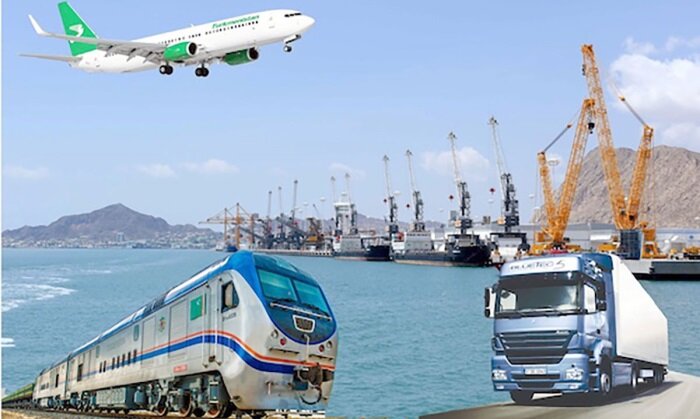The Karakum Desert is a sandy desert, the largest desert in Central Asia, one of the largest deserts on earth.
 In the modern world, deserts go through intensive agricultural and industrial development. It is a difficult and important task. On one hand, it requires increased costs, the use of special methods and technical means, on the other hand; it is closely related to the issues of environmental protection, a favorable ecological situation. The main condition for the existence of life in the desert is the presence of water in it.
In the modern world, deserts go through intensive agricultural and industrial development. It is a difficult and important task. On one hand, it requires increased costs, the use of special methods and technical means, on the other hand; it is closely related to the issues of environmental protection, a favorable ecological situation. The main condition for the existence of life in the desert is the presence of water in it.
On April 27, scientific expert of CentralAsia.news, the famous Turkmen scientist, Doctor of Technical Sciences Allaberdy Ilyasov commented on the role of the development of the largest desert in Central Asia, the Karakum Desert in the economic development and preservation of the ecosystem of Turkmenistan.
Endless ocean of sands
Deserts and drylands play a vital role in climate regulation — nearly 46 percent of the world’s carbon is stored in drylands, according to the UN and UNESCO. Despite the harsh conditions, they are home to more than 2 billion people and a haven for the world’s rarest biodiversity.
The category of typical deserts includes 23 percent of the land area. The largest of these is the Great Antarctic Desert. The Sahara Desert in North Africa — the largest in the world — has a surface area of approximately 9 million square km, which is comparable to the territory of the United States of America.
These are the Thar Desert in India, the Gobi Desert in China and Mongolia, the Great American Desert, the Kalahari Wasteland in South Africa, the Great Australian Desert, and the Atacama Desert in northern Chile.
Other large deserts are found in the Arabian Peninsula and Iran, which can be considered an extension of the Sahara Desert. They also include the Karakum Desert in Turkmenistan.
The largest desert in Central Asia
The Karakum Desert is a sandy desert, the largest in Central Asia, one of the largest on earth. It occupies almost ¾ of the territory of Turkmenistan. It is located between the foothills of the Kopetdag, Karabil and Badhyz in the south, the Khorezm lowland in the north, the Amudarya valley in the east and the channel of the Western Uzboy in the west. The length of the Karakum desert along the parallel is about 800 km, along the meridian — about 450 km, the total area is more than 350 thousand square km.
It exceeds the territory of states such as Great Britain, Italy or Norway. Taking into account the peculiarities of the geological structure, relief, soil and vegetation of various parts of the Karakum Desert, scientists divide them into Zaunguz (Northern), Low (Central) and South-Eastern.
Underground seas of the planet
Huge reserves of water are hidden in the bowels of the Earth. Freshwater underground seas are found on all continents and under all deserts. It means that the most common way for water to enter the underground storage facilities of the desert is the previously existing branched network of waterways and basins. Until that time, until the movement of the continents changed the angle of inclination of the earth’s surface, the flow of water went by gravity.
The water partially evaporated, and partially remained in the depths of the earth, where numerous galleries and storage tanks were dug over the years of moisture flow. Such water remains conserved for many millennia, only occasionally rising to the surface. Outputs of preserved water to the surface are formed in the places of the least deep underground storage facilities.
Ground water is a very important natural resource and plays a significant role in the economy. It is the main source of water for irrigation and food processing. In general, groundwater is a reliable source of water for agriculture and can be used flexibly.
Strategic resource
In the 21st century, water has become one of the key strategic resources of states. Today, a ton of fresh water in the countries of the arid belt is more expensive than oil. In the current economic and political realities, water security is becoming one of the main conditions for maintaining stability throughout the world.
According to forecasts of WMO experts and other international organizations, fresh drinking water supplies are not unlimited, and they are already coming to an end. By the middle of the 21st century, about 75 percent of the world’s population will lack fresh water. But effective management of water resources at the global level contributes to the strengthening of peace, security and cooperation between peoples, which is in line with the purposes and principles of the United Nations. One of the most important activities of this authoritative international organization is overcoming the global crisis of shortage of fresh drinking water.
A rational approach to the problem
In most desert regions, where groundwater is highly mineralized and unsuitable for household and drinking purposes, it is not possible to extract fresh water on site in the required quantities, therefore, the problem arises of transferring water to these places from nearby sources using water pipelines. Currently, the construction of water pipelines of various capacities and purposes is carried out in many countries of the world on a large scale. And here an example of prudent water use by Libya is indicative.
Libya is located in the middle of the Sahara. And since there are no bodies of water, the Libyan authorities created real rivers right underground! The state stands on a very arid land: in some regions there is no precipitation for five to ten years. To provide water to the Libyans, an underground network of giant water pipes was made in the country, and it stretched across the country. Water was found in the south of Libya back in 1953, when new oil fields were developed. It turned out that under the sands of the Sahara there are several pools with fresh water.
In 1984, in Al-Buraik, the first stone for the construction of a pipe production plant was laid, and the project started. The pipes needed were not the simplest ones; they were up to four meters in diameter. Wells were dug in the desert; some of them went into the bowels of the earth for half a kilometer: they pumped out fresh water into them.
A total of 1,300 wells were created. Now the giant water supply comes from there. It supplies water to the largest Libyan cities, the first of which was Tripoli in 1996. The water supply system stretches for 2800 kilometers. And now new man-made oases have been created in this country and large tracts of cultivated fields have become green.
Finding of Chinese scientists
The Takla-Makan Desert is an endless sea of sand under the hot sun. It stretches in the western part of China, occupying the Tarim depression, between the Tien Shan mountains in the north and the Kunlun mountains in the south. Experts from the Chinese Academy of Sciences have discovered that abnormally high absorption of carbon dioxide occurs in this lifeless area. Such processes are usually observed over forests or water bodies, but it is not typical for the desert. Scientists went in search of its cause.
There was no limit to surprise when colossal reserves of water were discovered under the layers of sand. According to rough estimates, the volume of water under the desert exceeds the reserves of the Great Lakes in America at times and it can be used for the needs of industry or agriculture. According to experts, the water under the desert has accumulated as a result of its geological structure.
Located in a vast depression surrounded by large mountain systems, Takla-Makan is a natural place for the flow of thawed spring waters. But, as it turned out, not all water evaporates under the scorching rays of the sun and dissolves without a trace in this sandy sea. Some part, having penetrated the sands, accumulates over the water-resistant rocks and forms a colossal accumulation of water, which experts have already dubbed the «underground ocean».
Freshwater lenses of the Karakum desert
More than fifty years ago, only a small part of the Karakum Desert was explored. Like the sandy deserts of the Sahara and Taklamakan, where gigantic reserves of water were found, the Karakum Desert is likely to also harbor global water lakes. The largest accumulations of groundwater were formed in the ancient valleys of the Amudarya, Murgab, Tejen and Uzboy rivers.
So far, eight such freshwater lenses with total static reserves of more than 60 cubic km have been examined. These are the Yaskhan, Cherkezli, Balku, East Zaunguz, Djillikum, Repetek, Karabil and Badhyz underground lenses.
They are related to freshwater basins — Yaskhan, East-Zauiguz, between Tejen and Murghab, etc. The dimensions of these basins reach several thousand square kilometers.
The most remarkable is the Yaskhan lens, which occupies the central part of the Priuzboy Karakum desert in the dry channel of the Uzboy River, which flowed from Lake Sarykamysh, which had the Praamudarya waters in the Upper Quaternary Age. True, the equipment for detecting groundwater at that time was less accurate for determining reserves and the ability to detect deeper deposits.
Currently, there are modern methods, as well as innovative equipment for detecting water reserves at a depth of several kilometers.
Today, a complete study of our desert is relevant, not only for the search for hydrocarbons and other minerals, but also for the discovery and study of underground desert lakes. Because its own water reserves for any country are the determining factor of independence.
Desert transformation
The Karakum Desert is mainly a country of natural pastures that make it possible to develop animal husbandry and, in particular, its least labor-intensive and at the same time the most profitable industry — the breeding of Karakul sheep.
Pastures are good in spring, when they are densely overgrown with various grasses. And now the flourishing future of the Karakum Desert is real and concrete from the results achieved.
A wide and widening line of oases stretches along the Karakum River. Highways, canals, power lines, water conduits leave it deep into the sands; many settlements, oil and gas fields grow in the central regions of the desert.
Thus, the careful use of natural resources, the introduction of innovative technologies and, in general, the provision of our country with water, are in the rank of priorities of the state policy pursued by President Gurbanguly Berdimuhamedov. All large-scale national reform programs in the economic sector and social sphere are closely related to the environmental component as the most important condition for a prosperous life in all respects.





